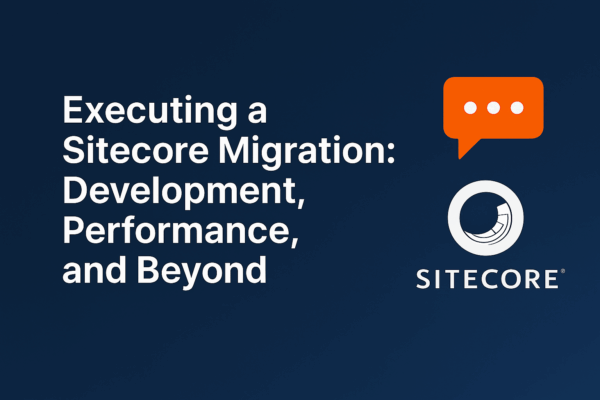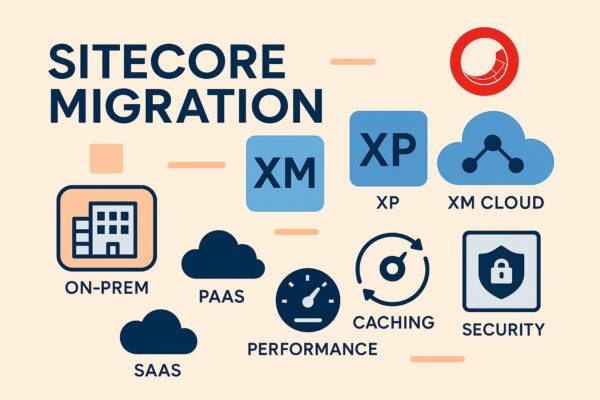In previous blog, the strategic and architectural considerations that set the foundation for a successful Sitecore migration is explored. Once the groundwork is ready, it’s time to move from planning to execution, where the real complexity begins. The development phase of a Sitecore migration demands precision, speed, and scalability. From choosing the right development environment and branching strategy to optimizing templates, caching, and performance, every decision directly impacts the stability and maintainability of your new platform.
This blog dives into the practical side of migration, covering setup best practices, developer tooling (IDE and CI/CD), coding standards, content model alignment, and performance tuning techniques to help ensure that your transition to Sitecore’s modern architecture is both seamless and future-ready.Title (suggested): Executing a Successful Sitecore Migration: Development, Performance, and Beyond
1. Component and Code Standards Over Blind Reuse
- In any Sitecore migration, one of the biggest mistakes teams make is lifting and shifting old components into the new environment. While this may feel faster in the short term, it creates long-term problems.
- Missed product offerings: Old components were often built around constraints of an earlier Sitecore version. Reusing them as-is means you can’t take advantage of new product features like improved personalization, headless capabilities, SaaS integrations, and modern analytics.
- Outdated standards: Legacy code usually does not meet current coding, security, and performance standards. This can introduce vulnerabilities and inefficiencies into your new platform.
Accessibility gaps: Many older components don’t align with WCAG and ADA accessibility standards — missing ARIA roles, semantic HTML, or proper alt text. Reusing them will carry accessibility debt into your fresh build. - Maintainability issues: Old code often has tight coupling, minimal test coverage, and obsolete dependencies. Keeping it will slow down future upgrades and maintenance.
Best practice: Treat the migration as an opportunity to raise your standards. Audit old components for patterns and ideas, but don’t copy-paste them. Rebuild them using modern frameworks, Sitecore best practices, security guidelines, and accessibility compliance. This ensures the new solution is future-proof and aligned with the latest Sitecore roadmap.
2. Template Creation and Best Practices
- Templates define the foundation of your content structure, so designing them carefully is critical.
- Analyze before creating: Study existing data models, pages, and business requirements before building templates.
- Use base templates: Group common fields (e.g., Meta, SEO, audit info) into base templates and reuse them across multiple content types.
- Leverage branch templates: Standardize complex structures (like a landing page with modules) by creating branch templates for consistency and speed.
- Follow naming and hierarchy conventions: Clear naming and logical organization make maintenance much easier.
3. Development Practices and Tools
A clean, standards-driven development process ensures the migration is efficient, maintainable, and future-proof. It’s not just about using the right IDEs but also about building code that is consistent, compliant, and friendly for content authors.
- IDEs & Tools
- Use Visual Studio or VS Code with Sitecore- and frontend-specific extensions for productivity.
- Set up linting, code analysis, and formatting tools (ESLint, Prettier in case of JSS code, StyleCop) to enforce consistency.
- Use AI assistance (GitHub Copilot, Codeium, etc.) to speed up development, but always review outputs for compliance and quality. There are many different AI tools available in market that can even change the design/prototypes into specified code language.
- Coding Standards & Governance
- Follow SOLID principles and keep components modular and reusable.
- Ensure secure coding standards: sanitize inputs, validate data, avoid secrets in code.
- Write accessible code: semantic HTML, proper ARIA roles, alt text, and keyboard navigation.
- Document best practices and enforce them with pull request reviews and automated checks.
- Package & Dependency Management
- Select npm/.NET packages carefully: prefer well-maintained, community-backed, and security-reviewed ones.
- Avoid large, unnecessary dependencies that bloat the project.
- Run dependency scanning tools to catch vulnerabilities.
- Keep lockfiles for environment consistency.
- Rendering Variants & Parameters
- Leverage rendering variants (SXA/headless) to give flexibility without requiring code changes.
- Add parameters so content authors can adjust layouts, backgrounds, or alignment safely.
- Always provide sensible defaults to protect design consistency.
- Content Author Experience
Build with the content author in mind:
-
- Use clear, meaningful field names and help text.
- Avoid unnecessary complexity: fewer, well-designed fields are better.
- Create modular components that authors can configure and reuse.
- Validate with content author UAT to ensure the system is intuitive for day-to-day content updates.
Strong development practices not only speed up migration but also set the stage for easier maintenance, happier authors, and a longer-lasting Sitecore solution.
4. Data Migration & Validation
Migrating data is not just about “moving items.” It’s about translating old content into a new structure that aligns with modern Sitecore best practices.
- Migration tools
Sitecore does provides migration tools to shift data like XM to XM Cloud. Leverage these tools for data that needs to be copied. - PowerShell for Migration
- Use Sitecore PowerShell Extensions (SPE) to script the migration of data from the old system that does not need to be as is but in different places and field from old system.
- Automate bulk operations like item creation, field population, media linking, and handling of multiple language versions.
- PowerShell scripts can be run iteratively, making them ideal as content continues to change during development.
- Always include logging and reporting so migrated items can be tracked, validated, and corrected if needed.
- Migration Best Practices
-
- Field Mapping First: Analyze old templates and decide what maps directly, what needs transformation, and what should be deprecated.
- Iterative Migration: Run migration scripts in stages, validate results, and refine before final cutover.
- Content Cleanup: Remove outdated, duplicate, or unused content instead of carrying it forward.
- SEO Awareness: Ensure titles, descriptions, alt text, and canonical fields are migrated correctly.
- Audit & Validation:
- Use PowerShell reports to check item counts, empty fields, or broken links.
- Crawl both old and new sites with tools like Screaming Frog to compare URLs, metadata, and page structures.
5. SEO Data Handling
SEO is one of the most critical success factors in any migration — if it’s missed, rankings and traffic can drop overnight.
- Metadata: Preserve titles, descriptions, alt text, and Open Graph tags. Missing these leads to immediate SEO losses.
- Redirects: Map old URLs with 301 redirects (avoid chains). Broken redirects = lost link equity.
- Structured Data: Add/update schema (FAQ, Product, Article, VideoObject). This improves visibility in SERPs and AI-generated results.
- Core Web Vitals: Ensure the new site is fast, stable, and mobile-first. Poor performance = lower rankings.
- Emerging SEO: Optimize for AI/Answer Engine results, focus on E-E-A-T (author, trust, freshness), and create natural Q&A content for voice/conversational search.
- Validation: Crawl the site before and after migration with tools like Screaming Frog or Siteimprove to confirm nothing is missed.
Strong SEO handling ensures the new Sitecore build doesn’t just look modern — it retains rankings, grows traffic, and is ready for AI-powered search.
6. Serialization & Item Deployment
Serialization is at the heart of a smooth migration and ongoing Sitecore development. Without the right approach, environments drift, unexpected items get deployed, or critical templates are missed.
- ✅ Best Practices
- Choose the Right Tool: Sitecore Content Serialization (SCS), Unicorn, or TDS — select based on your project needs.
- Scope Carefully: Serialize only what is required (templates, renderings, branches, base content). Avoid unnecessary content items.
- Organize by Modules: Structure serialization so items are grouped logically (feature, foundation, project layers). This keeps deployments clean and modular.
- Version Control: Store serialization files in source control (Git/Azure devops) to track changes and allow safe rollbacks.
- Environment Consistency: Automate deployment pipelines so serialized items are promoted consistently from dev → QA → UAT → Prod.
- Validation: Always test deployments in lower environments first to ensure no accidental overwrites or missing dependencies.
Properly managed serialization ensures clean deployments, consistent environments, and fewer surprises during migration and beyond.
7. Forms & Submissions
In Sitecore XM Cloud, forms require careful planning to ensure smooth data capture and migration.
- XM Cloud Forms (Webhook-based): Submit form data via webhooks to CRM, backend, or marketing platforms. Configure payloads properly and ensure validation, spam protection, and compliance.
- Third-Party Forms: HubSpot, Marketo, Salesforce, etc., can be integrated via APIs for advanced workflows, analytics, and CRM connectivity.
- Create New Forms: Rebuild forms with modern UX, accessibility, and responsive design.
- Migrate Old Submission Data: Extract and import previous form submissions into the new system or CRM, keeping field mapping and timestamps intact.
- ✅ Best Practices: Track submissions in analytics, test end-to-end, and make forms configurable for content authors.
This approach ensures new forms work seamlessly while historical data is preserved.
8. Personalization & Experimentation
Migrating personalization and experimentation requires careful planning to preserve engagement and insights.
- Export & Rebuild: Export existing rules, personas, and goals. Review them thoroughly and recreate only what aligns with current business requirements.
- A/B Testing: Identify active experiments, migrate if relevant, and rerun them in the new environment to validate performance.
- Sitecore Personalize Implementation:
- Plan data flow into the CDP and configure event tracking.
- Implement personalization via Sitecore Personalize Cloud or Engage SDK for xm cloud implementation, depending on requirements.
✅Best Practices:
- Ensure content authors can manage personalization rules and experiments without developer intervention.
- Test personalized experiences end-to-end and monitor KPIs post-migration.
A structured approach to personalization ensures targeted experiences, actionable insights, and a smooth transition to the new Sitecore environment.
9. Accessibility
Ensuring accessibility is essential for compliance, usability, and SEO.
- Follow WCAG standards: proper color contrast, semantic HTML, ARIA roles, and keyboard navigation.
- Validate content with accessibility tools and manual checks before migration cutover.
- Accessible components improve user experience for all audiences and reduce legal risk.
10. Performance, Caching & Lazy Loading
Optimizing performance is critical during a migration to ensure fast page loads, better user experience, and improved SEO.
- Caching Strategies:
- Use Sitecore output caching and data caching for frequently accessed components.
- Implement CDN caching for media assets to reduce server load and improve global performance.
- Apply cache invalidation rules carefully to avoid stale content.
- Lazy Loading:
- Load images, videos, and heavy components only when they enter the viewport.
- Improves perceived page speed and reduces initial payload.
- Performance Best Practices:
- Optimize images and media (WebP/AVIF).
- Minimize JavaScript and CSS bundle size, and use tree-shaking where possible.
- Monitor Core Web Vitals (LCP, CLS, FID) post-migration.
- Test performance across devices and regions before go-live.
- Content Author Consideration:
- Ensure caching and lazy loading do not break dynamic components or personalization.
- Provide guidance to authors on content that might impact performance (e.g., large images or embeds).
Proper caching and lazy loading ensure a fast, responsive, and scalable Sitecore experience, preserving SEO and user satisfaction after migration.
11. CI/CD, Monitoring & Automated Testing
A well-defined deployment and monitoring strategy ensures reliability, faster releases, and smooth migrations.
- CI/CD Pipelines:
- Set up automated builds and deployments according to your hosting platform: Azure, Vercel, Netlify, or on-premise.
- Ensure deployments promote items consistently across Dev → QA → UAT → Prod.
- Include code linting, static analysis, and unit/integration tests in the pipeline.
- Monitoring & Alerts:
- Track website uptime, server health, and performance metrics.
- Configure timely alerts for downtime or abnormal behavior to prevent business impact.
- Automated Testing:
- Implement end-to-end, regression, and smoke tests for different environments.
- Include automated validation for content, forms, personalization, and integrations.
- Integrate testing into CI/CD pipelines to catch issues early.
- ✅ Best Practices:
- Ensure environment consistency to prevent drift.
- Use logs and dashboards for real-time monitoring.
- Align testing and deployment strategy with business-critical flows.
A robust CI/CD, monitoring, and automated testing strategy ensures reliable deployments, reduced downtime, and faster feedback cycles across all environments.
12. Governance, Licensing & Cutover
A successful migration is not just technical — it requires planning, training, and governance to ensure smooth adoption and compliance.
- License Validation: Compare the current Sitecore license with what the new setup requires. Ensure coverage for all modules, environments. Validate and provide accurate rights to users and roles.
- Content Author & Marketer Readiness:
- Train teams on the new workflows, tools, and interface.
- Provide documentation, demos, and sandbox environments to accelerate adoption.
- Backup & Disaster Recovery:
- Plan regular backups and ensure recovery procedures are tested.
- Define RTO (Recovery Time Objective) and RPO (Recovery Point Objective) for critical data.
- Workflow, Roles & Permissions:
- Recreate workflows, roles, and permissions in the new environment.
- Implement custom workflows if required.
- Governance gaps can lead to compliance and security risks — audit thoroughly.
- Cutover & Post-Go-Live Support:
- Plan the migration cutover carefully to minimize downtime.
- Prepare a support plan for immediate issue resolution after go-live.
- Monitor KPIs, SEO, forms, personalization, and integrations to ensure smooth operation.
Proper governance, training, and cutover planning ensures the new Sitecore environment is compliant, adopted by users, and fully operational from day one.
13. Training & Documentation
Proper training ensures smooth adoption and reduces post-migration support issues.
- Content Authors & Marketers: Train on new workflows, forms, personalization, and content editing.
- Developers & IT Teams: Provide guidance on deployment processes, CI/CD, and monitoring.
- Documentation: Maintain runbooks, SOPs, and troubleshooting guides for ongoing operations.
- Encourage hands-on sessions and sandbox practice to accelerate adoption.
Summary:
Sitecore migrations are complex, and success often depends on the small decisions made throughout development, performance tuning, SEO handling, and governance. This blog brings together practical approaches and lessons learned from real-world implementations — aiming to help teams build scalable, accessible, and future-ready Sitecore solutions.
While every project is different, the hope is that these shared practices offer a useful starting point for others navigating similar journeys. The Sitecore ecosystem continues to evolve, and so do the ways we build within it.





Excellent breakdown of the development phase in a Sitecore migration – I especially appreciated the emphasis on rebuilding templates rather than blindly re-using legacy components. Thanks for sharing such actionable insights!